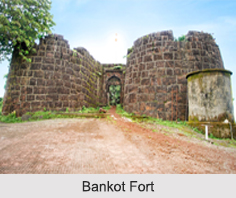 Bankot Fort is an important fort in Ratnagiri district of Maharashtra. The fort stands on the Bankot brook, the highest point on the junction where the famous River Savitri meets the gigantic Arabian Sea. Bankot fort is also known as "Himmatgad" and Fort "Victoria". It is believed that this fort, which is situated on the rocky terrain of the sea, was built in the Shilahara dynasty. The fort is primarily in ruins due to lack of use and maintenance.
Bankot Fort is an important fort in Ratnagiri district of Maharashtra. The fort stands on the Bankot brook, the highest point on the junction where the famous River Savitri meets the gigantic Arabian Sea. Bankot fort is also known as "Himmatgad" and Fort "Victoria". It is believed that this fort, which is situated on the rocky terrain of the sea, was built in the Shilahara dynasty. The fort is primarily in ruins due to lack of use and maintenance.
History of Bankot Fort
First record evidence about this fort is found in the records of Greek Traveller Ptolemy in 1st century AD. It was then called as "Mandargiri". The Chinese traveller Hieun Tsang is supposed to have embarked in Bankot in 640 AD. This fort was captured by the Portuguese from Mohammed Adil Shah of Bijapur in 1548. It was won by Maratha Koli Admiral Kanhoji Angre in 1700 and named as "Himmatgad". In 1755, the British forces captured the fort and named it as "Fort Victoria".
Structure of Bankot Fort
Bankot Fort is built with Lateritic rocks. The fort is surrounded by moats dug up in the lateritic rock. There are two gates to the fort. The northern entrance gate facing the Bankot creek is the main gate. The main entrance faces north and is decorated with stone carvings. In the vestibule on right side there are six water tanks. Climbing ahead is Nagarkhana which can be reached by climbing steps to view the glimpse of Savitri River and the surrounding region. From the western doorway, the bastion over the ramparts can be reached. There is a secret entrance near the bastion. This bastion was built by the Siddis to strengthen Bankot Fort. There is a temple of Lord Ganesha at the base of the fort.
Visiting Information of Bankot Fort
The base village of the fort is Bankot which is 47 km from Dapoli and 21 km from Shrivardhan. The trekking path to the fort starts from the hillock which is in the west of the Bankot village. Presently, there is a very safe and wide road up to the fort. It takes about half an hour to reach the entrance gate of the fort.



















